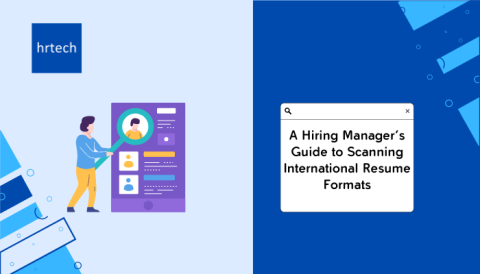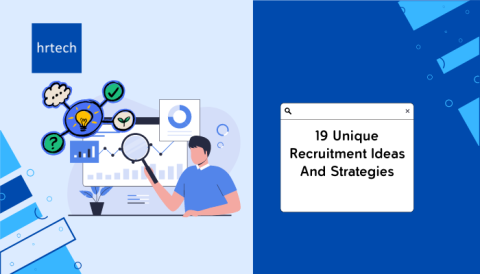Recruiting top talent is becoming more challenging with each passing day, and sticking to traditional methods just won’t cut it anymore. With an overwhelming number of applicants and fierce competition, it’s harder than ever to land the perfect candidate for your open roles.
That’s where recruitment technology steps in, and it’s not just a luxury anymore—it’s essential for staying ahead of your competitors. Companies today recognize the importance of recruitment technologies and are increasingly replacing manual processes with automated systems. The global recruitment technology market is projected to grow at a CAGR of 13.9% by 2032.
In this blog, we’ll explore how the latest tech can revolutionize your hiring process. You’ll find out how to streamline your recruitment funnel, reduce time-to-hire, and still keep that human connection.
What is Recruitment Technology?
Recruitment technology refers to the use of digital tools and software to streamline the hiring process. These tools help companies manage the entire recruitment process, from attracting candidates to finalizing hires. By automating key tasks, recruitment technology helps HR teams to work more efficiently and make data-driven decisions.
The evolution of modern recruitment technology is closely related to the evolution of communication technologies. The whole idea of communicating one’s skills and qualifications to a potential employer has changed considerably.
If you’re an experienced HR professional, you’ve likely spent hours sifting through resumes, manually entering data, and calling candidates for interviews. Modern digital recruitment technologies have automated these processes through AI and automation. In today’s competitive job market, these technologies are important to scale your workforce.
Now that you know what recruitment technologies are, let’s explore some benefits of using recruitment technologies.
Benefits of Using Recruitment Technologies
Recruitment technologies have transformed the hiring process, making it more efficient, data-driven, and scalable.
Here’s how they add value:
- Faster Hiring: Automates screening, scheduling, and communication to reduce time-to-hire.
- Better Candidate Matching: Uses AI to align job requirements with the most suitable candidates.
- Reduced Bias: Ensures fair and objective hiring through data-driven assessments.
- Better Candidate Experience: Keeps applicants engaged with automated updates and seamless interactions.
- Data-Driven Decisions: Provides insights to optimize hiring strategies and improve future recruitment.
Both small and large enterprises use recruitment technologies for the above benefits. Let’s take a look at some common recruitment technologies of 2025.
Important Recruitment Technologies of 2025
As we move into 2025, recruitment technology continues to evolve at a rapid pace. The tools and platforms that HR professionals rely on are becoming more advanced, offering smarter, faster ways to find and hire top talent.
Here are some recruitment technologies that are essential in 2025:
1. Applicant Tracking System (ATS)
An Applicant Tracking System (ATS) is a software solution designed to manage the hiring process more efficiently. It helps recruiters organize, track, and streamline applications, making it easier to find the right candidates.
ATS platforms automate the initial stages of recruitment, such as sorting resumes and tracking applicant progress. In 2025, ATS platforms are becoming more sophisticated with AI-driven features to identify top talent based on key qualifications. Modern ATS also integrates with job boards and other recruitment tools, centralizing all candidate information in one place.
Here are some of the key functions of applicant tracking systems:
- Resume Parsing: Automatically scans and extracts relevant information from resumes, speeding up the review process.
- Candidate Tracking: Tracks the progress of applicants through each stage of the recruitment process, from application to hire.
- Customizable Job Listings: Allows recruiters to create tailored job postings that can be easily shared across multiple job boards.
- Collaboration Tools: Promotes teamwork by enabling recruiters and hiring managers to leave notes, share feedback, and collaborate on candidates.
Examples: Recruit CRM, Hiresome, Lever, Greenhouse.
To find the best ATS in 2025, check out our blog, “Best Applicant Tracking Systems in 2025”.
2. Recruitment Marketing Platform
A Recruitment Marketing Platform (RMP) helps companies attract, engage, and nurture talent through targeted campaigns and content. It focuses on building a strong employer brand, creating a positive candidate experience, and driving job applications.
These platforms use marketing tactics like social media, email campaigns, and content to engage candidates before they apply.
Here are some of the key functions of RMPs:
- Employer Branding: Promotes your company’s culture, values, and mission to attract top talent.
- Job Distribution: Automatically shares job openings across various platforms, including social media, job boards, and career sites.
- Lead Nurturing: Engages passive candidates through targeted email campaigns and content to keep them interested over time.
- Analytics & Reporting: Tracks the performance of recruitment campaigns and provides insights into what attracts the best candidates.
Example: Manatal, Beamery, SmartDreamers
3. Candidate Relationship Management (CRM)
Candidate Relationship Management (CRM) systems help organizations build and maintain long-term relationships with potential candidates. These tools help recruiters to manage communication with both active and passive candidates, ensuring a steady talent pipeline.
Here are some of the key functions of CRM tools:
- Candidate Segmentation: Categorizes candidates based on skills, experience, and engagement levels for targeted communication.
- Automated Communication: Sends personalized emails, follow-ups, and job alerts to keep candidates engaged.
- Talent Pool Management: Centralizes candidate profiles and keeps track of interactions to build a strong pipeline for future roles.
- Data Insights & Reporting: Provides detailed reports on candidate engagement and pipeline health to help make data-driven decisions.
Example: Bullhorn, Avature, Jobvite
To find some of the best recruitment tools of 2025, check out our blog, “Top 17 Types Of Recruiting Tools For 2025 (With Examples)”.
4. Pre-Employment Assessment Tools
Pre-employment assessment tools are designed to evaluate candidates’ skills, cognitive abilities, and cultural fit before hiring. These tools help recruiters make more informed decisions by providing objective data on a candidate’s potential to succeed in a role. By using assessments, you can reduce hiring bias, ensure better job-fit, and predict job performance more accurately.
Here are some key functions of pre-employment assessment tools:
- Skill Testing: Evaluates candidates’ technical and soft skills to ensure they meet the job’s requirements.
- Personality Assessments: Helps determine whether a candidate’s personality aligns with the company culture and role expectations.
- Cognitive Ability Tests: Measures critical thinking, problem-solving, and learning ability to assess a candidate’s potential.
- Customizable Assessments: Tailors assessments to specific roles or industries to provide more relevant insights into candidates.
Examples: Mercer Mettl, Xobin, PMaps.
5. Onboarding Software
Onboarding software helps companies streamline and automate the process of integrating new hires into their organization. These platforms simplify tasks such as document submission, training, and introductions to company culture, ensuring new employees feel welcomed and prepared on day one.
Here are some key functions of onboarding software:
- Document Management: Automates the collection and storage of new hire paperwork, such as contracts and tax forms.
- Task Automation: Assigns and tracks onboarding tasks like setting up email accounts and providing access to software tools.
- Training Modules: Provides structured training programs to help new employees get up to speed quickly.
- Employee Engagement: Introduces new hires to the company culture with interactive elements like videos, surveys, and team introductions.
Examples: BambooHR, Leap Onboard, Gusto.
6. Reference Checking Software
Reference checking software automates the process of verifying a candidate’s past work performance and professional reputation. It streamlines communication with referees, ensuring a faster and more reliable way to gather feedback.
Here are some key functions of reference checking software:
- Automated Reference Requests: Sends emails to referees and collects responses without manual follow-ups.
- Anonymous Feedback Collection: Allows referees to provide honest and structured feedback confidentially.
- Response Analysis: Identifies patterns, inconsistencies, and key insights from referee feedback.
- Detailed Reporting: Generates comprehensive reports to support data-driven hiring decisions.
Examples: Zinc, Xref, Crosschq.
7. Software for Diverse and Inclusive Hiring
Diversity hiring software helps organizations reduce bias in recruitment and build a more inclusive workforce. These tools use AI and data-driven strategies to ensure fair candidate evaluation and promote equal opportunities.
Here are some key functions of DEI software:
- Bias-Free Job Descriptions: Analyzes and suggests neutral language to attract diverse applicants.
- Blind Screening: Removes personal details like name, gender, and ethnicity to prevent unconscious bias.
- Diversity Analytics: Tracks diversity metrics and provides insights to improve hiring strategies.
- Inclusive Sourcing: Identifies and engages underrepresented talent through targeted outreach.
Examples: Applied, Textio, Blendoor.
8. Candidate Assessment Software
Candidate assessment software evaluates applicants’ skills, cognitive abilities, and personality traits to determine their suitability for a role. It provides data-driven insights to help recruiters make objective and informed hiring decisions.
Here are some of the key functions of candidate assessment software:
- Skill-Based Testing: Assesses technical, cognitive, and soft skills relevant to the job.
- Psychometric & Behavioral Assessments: Evaluates personality traits, problem-solving ability, and cultural fit.
AI-Powered Scoring: Automates evaluation and ranking of candidates based on performance. - Integration with HR Systems: Connects with ATS and other recruitment tools for seamless workflow.
Examples: HackerRank, Codility, Criteria Corp.
9. Candidate Experience Analytics Software
Candidate experience analytics software helps organizations measure and improve the hiring journey from the applicant’s perspective. By tracking feedback and engagement at every stage, these tools help companies to refine their recruitment process and enhance employer branding.
Here are some key functions of candidate experience analytics software:
- Candidate Feedback Collection: Gathers insights through surveys and feedback forms.
- Experience Analytics: Analyzes data to identify pain points and improve the hiring process.
- Quality of Hire Measurement: Assesses how well new hires fit and perform within the company.
- DEI Metrics Tracking: Evaluates diversity, equity, and inclusion efforts in recruitment.
Examples: Starred, Survale, Talentegy.
10. Video Interviewing Software
Video interviewing software helps companies to conduct remote interviews, saving time and resources while expanding the talent pool. These platforms allow recruiters to connect with candidates from anywhere in the world, offering both live and recorded interview options.
Here are some key functions of video interviewing software:
- Live Video Interviews: Helps in real-time, face-to-face interviews, mimicking the in-person experience.
- Pre-Recorded Interviews: Allows candidates to record responses to pre-set questions, enabling recruiters to review at their convenience.
- AI-Powered Analysis: Analyzes video interviews for speech patterns, facial expressions, and body language to help assess a candidate’s fit.
- Scheduling & Integration: Syncs with calendar tools to schedule interviews and integrates with applicant tracking systems for smooth workflows.
Examples: Zoom, HireVue, Spark Hire
While dedicated tools exist for each recruitment stage, many companies prefer using all-in-one HRMS solutions. To learn more, check out our blog, “How an All-in-One Hiring Platform Can Transform Your Recruitment Strategy”.
With all these powerful recruitment technologies in place, how do you measure their effectiveness on your hiring success? Let’s understand some metrics that you can use to measure the effectiveness of recruitment technologies.
How to Measure the Impact of Recruitment Technology?
Recruitment technologies are valuable, but measuring key metrics is essential to ensure they’re helping you attract and hire the best talent. There are many quantitative and qualitative ways to measure how recruitment technologies are contributing to your hiring efficiency.
Here are some key metrics that you should measure:
1. Time-to-Hire
Using the time-to-hire metric you can measure the time it takes from when a candidate enters your pipeline to when they accept an offer. A faster time-to-hire is often a sign that your recruitment technology is streamlining the process.
For example: After implementing an ATS, you observe that time-to-hire has reduced as compared to manual process. It indicates that ATS has been useful making your hiring more efficient.
2. Cost-per-Hire
Using cost-per-hire you can calculate the total cost of hiring for each position, including advertising fees, recruitment technology costs, and recruiter time. Over time, you’ll see whether your technology is helping reduce these expenses.
For example: You implement video interviewing software to conduct remote interviews, and if the cost-per-hire decreases, it shows the software is effectively reducing costs by eliminating the need for in-person interviews.
3. Candidate Satisfaction
You can measure candidate satisfaction both quantitatively and qualitatively. Gather feedback from candidates throughout the hiring journey to assess their experience. Higher satisfaction levels can lead to a stronger employer brand and more talent referrals.
For example: You implement a new onboarding software to automate documentation and training. If you get more positive feedback in candidate satisfaction surveys and fewer complaints, it shows the ATS is successfully improving the candidate experience.
4. Quality of Hire
Evaluate the performance of new hires against established benchmarks to ensure the best candidates are being selected. This metric highlights how well your recruitment technology is identifying top talent and overall quality of the hired talents.
For example: You use pre-employment assessment software to test candidates’ skills before the interview. If your new hires perform well and meet expectations, it shows the assessments are successfully helping you pick the right candidates for the job.
5. Offer Acceptance Rate
Offer acceptance rate measures the percentage of candidates who accept job offers compared to those who decline. A higher offer acceptance rate typically indicates a positive recruitment experience and alignment between the candidate and the company’s expectations.
For example: you use an Applicant Tracking System (ATS) to streamline the interview process and quickly send offer letters. If you see a higher acceptance rate, it suggests the ATS is helping create a smoother, more efficient process that makes candidates more likely to accept your offer.
Learn more on how to hire better from our blog, “A Smarter Approach to Hiring: Balancing Speed, Quality, and Experience”.
After discussing key metrics, let’s look at the factors to consider when selecting recruitment technology.
Key Considerations before Choosing Recruitment Technology
Choosing the right recruitment technology is essential to hire the right people into your organization. To make informed decisions, you need to take a few key factors into consideration.
Here’s what you need to consider when choosing recruitment technologies:
1. Company Size and Hiring Needs:
Choose recruitment technology based on your company’s size and hiring frequency. Large enterprises need feature-rich, integrated systems to handle bulk hiring, while small businesses benefit from simpler, cost-effective tools. If your hiring needs vary across different roles or departments, opt for a flexible system that can accommodate diverse recruitment processes.
2. Integration with Existing Systems
Seamless integration with your ATS, HRIS, and payroll systems prevents data silos and reduces manual work. A well-integrated system ensures smooth data transfer, minimizing errors and eliminating duplicate candidate entries. Compatibility with other tools, such as CRM or performance management software, further enhances efficiency.
3. User-Friendliness
A recruitment system should be intuitive and easy to use, minimizing the need for extensive training. A clean interface, straightforward navigation, and mobile compatibility help HR teams and candidates interact seamlessly. Additionally, access to support resources like tutorials and customer service can resolve issues quickly.
4. Budget
Beyond the upfront cost, consider long-term expenses such as subscription fees, training, and support. A cost-effective solution should provide a strong return on investment by reducing manual workload and improving hiring efficiency. Look for flexible pricing models, such as pay-per-user or tiered plans, to match your budget.
5. Scalability
As your company grows, your recruitment technology should be able to handle increasing hiring demands. Ensure the system can support a higher volume of candidates, job postings, and users without performance issues. Future-proof features, like AI-driven insights and machine learning capabilities, will help your hiring process evolve over time.
Visit hrtech marketplace to find the best recruitment software. Explore, compare and choose only on hrtech marketplace!
While modern recruitment technologies bring many advantages, they also come with certain challenges. Let’s explore some challenges of using recruitment technologies.
Challenges of Using Recruitment Technologies
While recruitment technologies increase efficiency, they also present certain challenges. You must address these to ensure a smooth hiring process and avoid potential issues in the long run.
Here are some of the challenges of using recruitment technologies:
- High Implementation Costs: Advanced tools can be expensive, requiring a significant investment in setup, training, and maintenance.
- Bias in AI Algorithms: Automated systems may unintentionally favor certain candidates, leading to biased hiring decisions.
- Integration Issues: Not all platforms seamlessly integrate with existing HR systems, causing workflow disruptions.
- Dependence on Data Quality: Inaccurate or incomplete data can lead to flawed hiring decisions and misaligned candidate matches.
- Candidate Experience Concerns: Over-reliance on technology may reduce human interaction, making the hiring process feel impersonal.
Check out hrtech marketplace to find the best HR software solutions for your organization. Schedule a call today!
Conclusion
Recruitment technology is transforming the hiring process, helping companies improve workflows, reduce costs, and enrich candidates’ experience. By measuring key metrics and choosing the right tools, organizations can ensure they are making the most of their recruitment technologies. It’s important to consider factors like integration, scalability, and budget before implementation to achieve the best results.
In your search for the right recruitment technology, hrtech is your ultimate partner. hrtech is the go-to platform for discovering the best recruitment technologies on the market. With a wide range of solutions tailored to different needs, hrtech makes it easy for companies to find tools that align with their recruitment goals.
Explore hrtech today and start optimizing your recruitment process with the best tools available. Schedule a call with experts and find the right recruitment solution today!





